

Refugees Magazine Issue 144 ("Where Are They Now? The Hungarian Refugees, 50 Years On") - Editorial: The 50th Anniversary of the Hungarian Uprising. Analysis/Editorials, 1 October 2006.
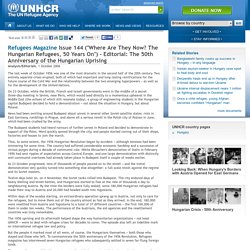
Eyewitnesses: Hungarian uprising. Escape from Hungary. The Hungarian Revolution began as a student demonstration demanding political reform and an end to Soviet occupation.
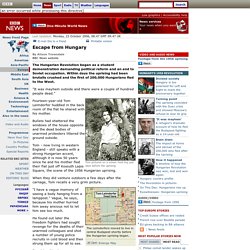
Traces Project. ‘I want to tell you about my first day in London.

Many years have passed since, but I can still remember clearly what I saw and felt on that day when I arrived from the camp.’ – The opening to Refuge England, 1959. Refuge England (1959) Like the Swiss makers of Nice Time (d.
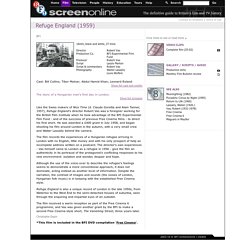
Claude Goretta and Alain Tanner, 1957), Refuge England's director Robert Vas was a foreigner working for the British Film Institute when he took advantage of the BFI Experimental Film Fund - and of the succcess of previous Free Cinema films - to direct his first short. He was awarded a £400 grant in July 1958, and began shooting his film around London in the autumn, with a very small crew and Walter Lassally behind the camera. The film records the experiences of a Hungarian refugee arriving in London with no English, little money and with his only prospect of help an incomplete address written on a postcard. The director's own experiences - Vas himself came to London as a refugee in 1956 - give the film an authenticity in its portrayal of the protagonist's conflicting responses to his new environment: isolation and wonder, despair and hope.
Christophe Dupin *This film is included in the BFI DVD compilation 'Free Cinema'. Eyewitness: The Hungarian Uprising of 1956. Fifty years ago Russian tanks rolled across the border into Hungary to quell an uprising against Soviet rule.
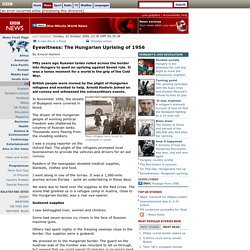
Central Europe Review - Hungary: The Welcome Refugees. H U N G A R Y:The Welcome RefugeesWhy the West opened its arms to fleeing Hungarians in 1956 Paul Nemes Forty-three years ago, Hungary enjoyed a few days of freedom, followed by a brutal crushing of the democratic forces by Soviet Communism.
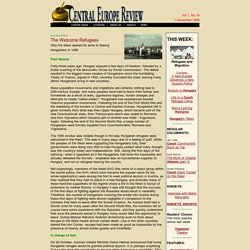
The defeat resulted in the biggest mass exodus of Hungarians since the humiliating Treaty of Trianon, signed in 1920, severely truncated the state, leaving many ethnic Hungarians living in new countries. Mass population movements and migrations are certainly nothing new to 20th-century Europe, and many peoples have had to leave their homes and homelands as a result of wars, oppressive regimes, border changes and attempts to create "nation-states". Hungarians had experienced several massive population movements. The 1956 exodus was notable though in the way Hungarian refugees were welcomed in the West. A change of tack On 26 October, Austrian Interior Minister Oskar Helmer announced that every Hungarian refugee would be granted political asylum.
Hungarians in the United Kingdom. Hungarians in the United Kingdom include Hungarian born immigrants to the UK and their descendants, of which there are a substantial number.
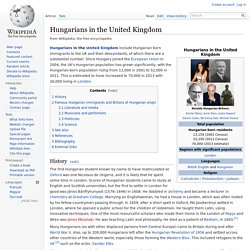
Since Hungary joined the European Union in 2004, the UK's Hungarian population has grown significantly, with the Hungarian-born population rising from 13,000 in 2001 to 52,000 in 2011. This is estimated to have increased to 70,000 in 2013 with 26,000 living in London. History[edit] The first Hungarian student known by name to have matriculated at Oxford was one Nicolaus de Ungeria, and it is likely that he spent some time in London. Scores of Hungarian students came to study at English and Scottish universities, but the first to settle in London for good was János Bánffyhunyadi (1576–1646) in 1608.
Many Hungarians (as with other displaced persons from Central Europe) came to Britain during and after World War II. Since Hungary joined the European Union in 2004, the UK's Hungarian population has grown significantly. Literature and media[edit] Hungarian Revolution of 1956. The Hungarian Revolution of 1956 or Hungarian Uprising of 1956[5] (Hungarian: 1956-os forradalom or felkelés) was a spontaneous nationwide revolt against the government of the Hungarian People's Republic and its Soviet-imposed policies, lasting from 23 October until 10 November 1956.
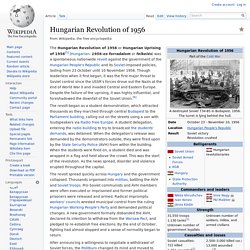
Though leaderless when it first began, it was the first major threat to Soviet control since the USSR's forces drove out the Nazis at the end of World War II and invaded Central and Eastern Europe. Despite the failure of the uprising, it was highly influential, and foreshadowed the downfall of the Soviet Union.[6] The revolt began as a student demonstration, which attracted thousands as they marched through central Budapest to the Parliament building, calling out on the streets using a van with loudspeakers via Radio Free Europe. A student delegation, entering the radio building to try to broadcast the students' demands, was detained.